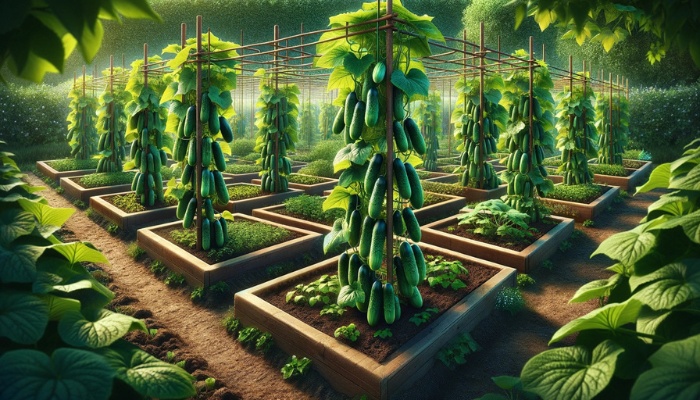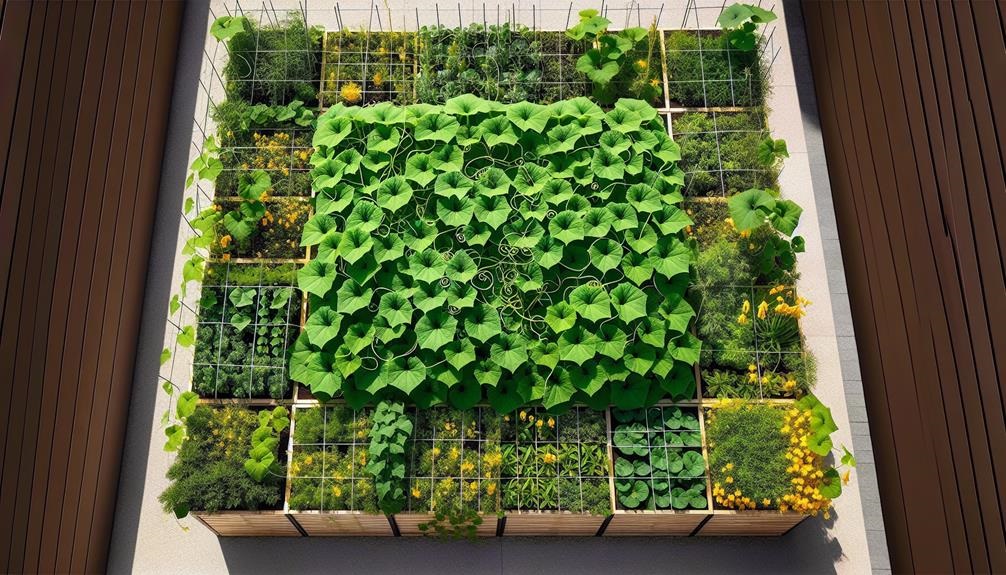Using the square foot gardening method to grow cucumbers is all about maximizing yield in a minimal space, yet the process can be as intricate as it is rewarding.
From selecting the right cucumber varieties that thrive in confined areas to mastering the art of spacing and vertical gardening, you’ve got your work cut out for you.
However, with a little know-how and a few pointers, you’ll soon be confident in your skills and reaping the rewards of your efforts.
Choosing the Right Varieties
Selecting the ideal cucumber variety hinges on understanding the specific growth habits and resistance profiles of each option.
When choosing your variety, you’ve got to weigh whether you’re aiming for cucumbers that excel in vertical growth—ideal for trellising which maximizes your square footage—or if you prefer varieties that sprawl across the ground.
Bear in mind that trellising your cucumbers not only saves space but also promotes better air circulation around the plants, reducing the risk of disease. It also makes harvest timing more straightforward, as the fruits are more visible and accessible.
You’ll want to select varieties known for their disease resistance and productivity within confined spaces.
These characteristics ensure that you’re not just growing cucumbers but you’re growing them efficiently with a keen eye on both the growth process and the end goal— a bountiful harvest.
Cucumber trellising and harvest timing aren’t just considerations—they’re key to your success. Your choice shapes your garden’s structure, health, and yield, so invest time in understanding each variety’s needs and benefits.
Preparing Your Square Foot Bed
After choosing the right cucumber varieties for your square foot garden, it’s time to focus on preparing your bed to ensure those selections thrive in their new environment.
The foundation of a thriving garden lies in the soil. Begin by testing the soil pH, aiming for a range between 6.0 and 6.8, which is ideal for cucumbers. Adjusting your soil’s pH might require the addition of lime or sulfur, depending on the initial results.
Proper drainage and nutrient-rich soil are non-negotiable for cucumbers. Incorporate a balanced mix of compost, vermiculite, and peat moss to create an environment where cucumbers can flourish.
This mix ensures your soil is loose and fertile, with adequate drainage to prevent waterlogging.
Mulching options play a pivotal role in retaining moisture and regulating soil temperature. Here’s a quick guide:
| Mulch Type | Benefits |
|---|---|
| Straw | Improves moisture retention and adds organic matter |
| Leaf mulch | Insulates soil and retains moisture |
| Wood chips | Long-lasting and suppresses weeds |
Planting and Spacing Techniques

To ensure optimal growth and yield in your square foot garden, it’s critical to master the art of cucumber planting and spacing techniques.
Understanding the specifics can make a significant difference in the success of your cucumbers, from soil temperature considerations to the implementation of vertical trellising. Here’s what you need to know:
- Check Soil Temperature: Before planting, ensure the soil temperature is consistently above 60°F. Cucumbers thrive in warm conditions, and cold soil can impede germination.
- Planting Depth and Spacing: Plant cucumber seeds 1 inch deep, spacing them about 2 to 3 feet apart if you’re not using vertical trellising. This spacing allows ample room for growth and air circulation, which are vital for healthy plants.
- Utilize Vertical Trellising: To maximize space and encourage vertical growth, install a trellis at planting time. Vertical trellising saves space and promotes air circulation, reducing the risk of diseases.
- Grouping Plants: In a square foot garden, consider planting two cucumber plants per square foot if using a trellis. This density is optimal for balanced growth and yield.
Watering and Feeding Guidelines
While mastering planting and spacing is key, it’s equally important to understand the specific watering and feeding requirements that cucumbers need for optimum growth. Cucumbers are particularly thirsty plants, requiring consistent moisture, especially during fruiting stages.
Ideally, you’ll want to implement a drip irrigation or soaker hose system in your square foot garden. These watering systems ensure water is delivered directly to the roots, minimizing evaporation and reducing the risk of leaf diseases.
When it comes to feeding, cucumbers benefit greatly from a balanced, slow-release fertilizer applied at planting and then again mid-season.
However, the trick lies in not overdoing it. Excessive nitrogen can lead to lush foliage at the expense of fruit production.
To retain moisture and regulate soil temperature, applying a layer of organic mulch is advisable. Mulch types like straw or shredded bark are excellent options.
They not only keep the soil moist but also help in preventing weed growth, which competes with cucumbers for nutrients. A consistent watering schedule, coupled with strategic feeding and the right mulch, will set your cucumbers up for a bountiful harvest.
Managing Pests and Diseases
Addressing pest and disease management in your square foot garden is crucial for ensuring your cucumbers reach their full potential without succumbing to common threats.
By taking a proactive approach, you’ll not only protect your cucumbers but also promote a healthier, more productive garden.
Here are four key strategies to effectively manage pests and diseases:
- Implement Cucumber Trellising: Elevating cucumbers off the ground using trellises significantly reduces the risk of soil-borne diseases and makes it harder for pests to reach the plants. This method also improves air circulation around the foliage, further diminishing disease risk.
- Apply Mulching Benefits: Mulch serves as a barrier, preventing soil-borne pathogens from splashing onto the leaves during watering. It also maintains soil moisture, which can help reduce stress on the plants, making them less susceptible to disease and pest infestation.
- Monitor for Pests Regularly: Early detection is key. Inspect your cucumbers frequently for signs of pests, such as aphids, cucumber beetles, and spider mites. Catching an infestation early can make management much more manageable.
- Use Organic Pest Controls: When intervention is necessary, opt for organic pest control methods. Neem oil, insecticidal soaps, and diatomaceous earth are effective, environmentally friendly options that can help keep your garden healthy without resorting to harsh chemicals.

